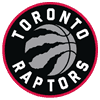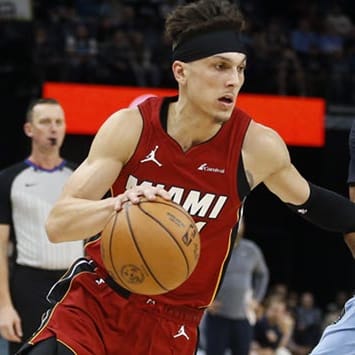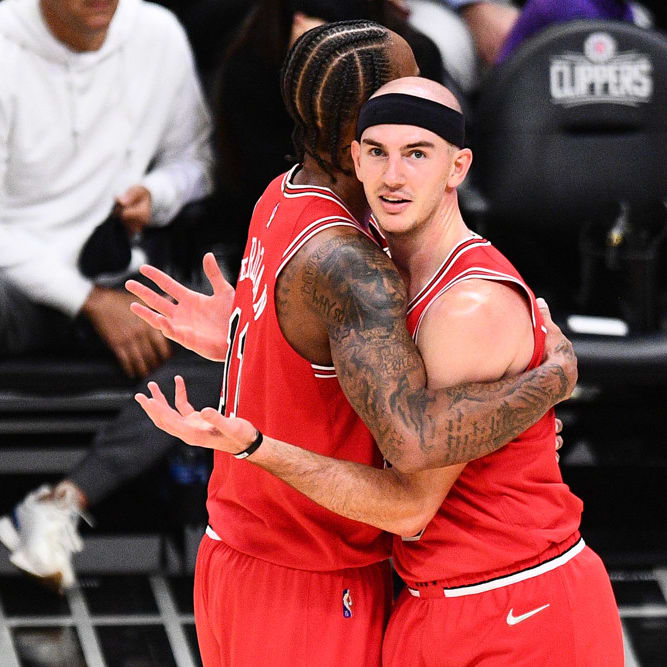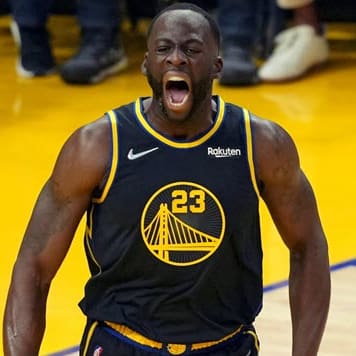This article is part of our NBA Team Previews series.
 STATE OF THE FRANCHISE
STATE OF THE FRANCHISE
Heading into last season, not much was expected from the Raptors. The hiring of Masai Ujiri as general manager to replace Bryan Colangelo provided reason for optimism in the long term, but the team Ujiri inherited didn't seem entirely geared for success. Analytics whipping boy Rudy Gay and his max contract headlined a top-heavy roster that also included temperamental point guard Kyle Lowry, young wing scorer DeMar DeRozan, and younger center Jonas Valanciunas, but a lack of experience and lack of depth had most people projecting another lottery finish for the franchise. Then, after the team limped out to a 6-12 start, Ujiri somehow found a taker for Gay, sending the forward to Sacramento for a package of players that, while not stars, gave the bench a massive upgrade and provided coach Dwane Casey with more willing participants in his system. Suddenly free of Gay's shadow, both DeRozan and Lowry exploded for career years, with DeRozan earning his first All-Star berth, and they led the Raptors to a franchise record 48 wins, playing 20 games over .500 the rest of the way and pulling down their first Atlantic Division crown since 2007. A hard-fought seven game series against Brooklyn saw the veteran Nets barely squeak by in the first round of the playoffs, but the quick exit did little to put a damper on the surprisingly successful season for the Raptors.
Rather than making more big changes to the roster, Ujiri elected to keep his core intact and let them build on the chemistry they showed during their drive to the postseason. Lowry was re-signed to a big four-year contract, and key bench players Greivis Vasquez and Patrick Patterson were given new deals. Louis Williams, James Johnson, and Lucas Nogueira were also brought on board to further improve the Raptors' depth, but the most shocking addition came in the draft, when Ujiri – still stinging after missing out on Giannis Antetokounmpo in the 2013 NBA Draft – nabbed freakishly athletic Brazilian teenager Bruno Caboclo with the 20th-overall pick. Caboclo is extremely raw and won't be ready to contribute for a couple of years yet, but his ceiling seems nearly unlimited, and he could eventually be the elite franchise talent the Raptors haven't been able to find since Vince Carter was in his prime.
Expectations have now changed in Toronto. Given the run of sustained regular season success they enjoyed after the Gay trade, the youth and talent on the roster, and the steady hands in the front office and sidelines, the Raptors look very much like a team on the rise and one capable of being a regular threat for the postseason in the Eastern Conference. Whether they can take the next step and become a threat for an NBA title depends in large part on whether someone can emerge as a true franchise talent, be it DeRozan, Valanciunas, or even Caboclo.
PLAYING TIME DISTRIBUTION
The starting backcourt will see huge minutes together, with Kyle Lowry getting in the 33-36 minutes range and DeMar DeRozan soaking up even more, playing 35-38 minutes. Greivis Vasquez should see 15-18 minutes mostly behind Lowry or in place of him when Lowry gets banged up, as he's inclined to do, while new addition Louis Williams might get 10-13 minutes behind the iron man DeRozan. Will Cherry will soak up any garbage-time minutes as the third point guard. At forward, Terrence Ross should see 25-28 minutes as the starting three unless his development stagnates, while Amir Johnson will also play 25-28 minutes at power forward as the health of his ankles allow. Patrick Patterson should get most of the minutes behind Johnson, playing 21-24 minutes while moving into the starting lineup should Johnson break down, with Tyler Hansbrough also seeing 8-11 minutes. Minutes behind Ross will be a competition among James Johnson (18-21), Jordan Hamilton (8-11), and Landry Fields (5-8), with rookie Bruno Caboclo getting extremely sparse court time at both the three and four while he gets his feet wet in the pros. In the middle, Jonas Valanciunas should expand his court time into the 29-32 minute range, with Lucas Nogueira seeing 11-14 minutes behind him and Chuck Hayes also getting occasional use (5-8 minutes). Amir Johnson often slides over to center as well when the Raptors go with a smaller lineup.
PLAYER OUTLOOKS
Centers
Jonas Valanciunas: Young centers can often take some time to blossom, and Valanciunas was no exception in his second NBA campaign. The 22-year-old Lithuanian still turned in solid numbers as he played in and started 81 games, averaging 11.3 points, 8.8 rebounds, and 0.9 blocks in 28 minutes per game while shooting 53 percent from the floor and an impressive-for-a-big 76 percent from the free-throw line (albeit on just 3.2 attempts per game). He was out of position too often on the defensive end to take full advantage of his shot-blocking potential, and despite the slew of talented, athletic guards and wings around him on the Raptors' roster, Valanciunas still tries to do a little too much offensively. He's got good size and athleticism and is developing a solid mid-range shot, and as his skills and maturity catch up with his physical tools, Valanciunas should become a consistent double-double threat. With DeMar DeRozan and Kyle Lowry in place as the backcourt engine of the Raptors, the club is prepared to take their time and let Valanciunas develop at his own pace. He may not break out in 2014-2015, but he should take another step forward.
Lucas Nogueira: On his third NBA organization before he's even played a game in the NBA, Nogueira had his European contract bought out after the Hawks dealt him to the Raptors, and he'll make his North American debut this season. Possessing good size and athleticism, the 22-year-old Brazilian was named the best defender in Spain's top league last season, and he should be able to develop into an effective shot-blocker once he gets acclimated to the Association. That process should be a bit smoother thanks to the presence of fellow Brazilian rookie, and first-round pick, Bruno Caboclo on the Raptors' roster. Nogueira's positivity and passion for the game (not to mention his giant hairdo) have already drawn notice from his more veteran teammates. Jonas Valanciunas has the starting center spot locked up in Toronto, so Nogueira will need to earn his minutes off the bench, but he appears to be yet another young, hungry, high-upside asset on a Toronto roster looking to build on last season's surprising postseason appearance.
Chuck Hayes: An undersized, unathletic center who survives on guile and experience, Hayes joined the Raptors in the Rudy Gay trade and helped provide some battle-tested experience to a young roster. Playing in 61 games between Sacramento and Toronto, Hayes' numbers were modest (2.2 points and 3.4 rebounds in 12 minutes per game while shooting 43 percent from the floor and an out-of-character 80 percent from the free-throw line). Now that he's on the wrong side of 30, his career seems just about ready to draw to a close after 10 NBA seasons. The Raptors feature a pair of young centers ahead of him on the depth chart in Jonas Valanciunas and Lucas Nogueira, and the club will keep Hayes around to impart what lessons he can to the duo and help turn them into polished pros before he rides off into the sunset, or at least to another organization in need of his particular skill set.
Forwards
Amir Johnson: Heading into his 10th NBA season, Johnson is effectively the old man in a young Raptors' starting lineup, but as one of the last players to jump directly from high school to the NBA, he's amazingly still just 27 years old. The power forward's standout athleticism can create problems for larger, slower opponents at both ends of the court, and while he isn't a focus of the Raptors' offense, Johnson supplies more than his share of highlight reel putbacks and slams when the opportunity presents itself. Johnson played in 77 games last season and averaged a career-high 10.4 points, 6.6 rebounds, 1.5 assists, and 1.1 blocks in 29 minutes per game while shooting 56 percent from the floor and 64 percent from the free-throw line. He even added a little three-point shooting to his arsenal as a nice bonus for his fantasy owners, hitting on 20 of 66 attempts from beyond the arc. Lower body injuries have become an issue over the last couple of seasons, and heading into the final year of his contract, there's some question about Johnson's future in Toronto. If he can stay healthy, though, Johnson could follow in Kyle Lowry's footsteps and come through with a big contract year.
Terrence Ross: When Rudy Gay was dealt to Sacramento early last season, second-year wing Terrence Ross inherited the starting small forward spot and found some success, including a 51-point explosion against the Clippers in late January. Ross' overall numbers in 62 starts were solid for a player without a key role in the offense, as he averaged 12.2 points, 3.3 rebounds, 2.3 three-pointers, 1.1 assists, and 0.9 steals in 29 minutes per game, with shooting percentages of 43 percent from the field, 85 percent from the free-throw line, and 40 percent from beyond the arc. Even more will be expected from Ross this time around. He's got the elite athleticism and hops to be a force at both ends of the court, and with DeMar DeRozan's frequent visits to the free-throw line as a model, Ross should be able to start finding ways to attack the basket on a more consistent basis. The re-acquisition of James Johnson in the offseason could provide a threat to Ross' minutes, as Johnson offers a little more length on defense from the small forward spot, but barring a training camp disaster, Ross' starting spot at the three should be secure.
Patrick Patterson: Traded for the second time in as many seasons, Patterson found new life in his game once he arrived in Toronto and became a key member of their revitalized second unit. The fourth-year stretch power forward saw increases in his numbers almost across the board after the deal, and between Sacramento and Toronto, he averaged 8.5 points, a career-high 5.3 rebounds, 1.2 assists, 0.8 steals, 0.8 three-pointers, and 0.6 blocks in 24 minutes per game over 65 games while shooting 46 percent from the field, 36 percent from the beyond the arc, and 70 percent from the free-throw line. Like most of the Raptors' young roster, Patterson is an athletic specimen, and his well-rounded skill set allows him to contribute on the court in all situations and see plenty of minutes in crunch time. Starting power forward Amir Johnson is in the final year of his contract and has had trouble staying healthy recently, so after Patterson signed a three-year deal this offseason to remain in Toronto, there could be opportunities for him to see increased minutes and production this season with an eye toward him inheriting Johnson's spot in the starting five in 2015-16.
James Johnson: After two seasons of sporadic minutes off the bench in Sacramento and Memphis, Johnson returns to a Toronto organization in much better shape than the one he left. He started 65 games for the Raptors in 2010-2011 and 2011-2012, but with Terrence Ross installed as the starting small forward, Johnson will be utilized primarily as a defensive stalwart on the second unit, a job in which he should be able to thrive given his length and athleticism. Last season, the sixth-year forward played in 52 games for the Grizzlies, averaging 7.4 points, 3.2 rebounds, 2.1 assists, 1.1 blocks, 0.8 steals, and 0.4 three-pointers in 18 minutes per game while shooting 46 percent from the field, 84 percent from the free-throw line, and 25 percent from beyond the arc. Johnson chafed against his limited role in his first tour of duty with Toronto, often trying to do too much on offense, but with more maturity under his belt and a roster around him more likely to get him to the playoffs, Johnson seems better prepared to be a lunch-bucket bench player this time around.
Tyler Hansbrough: Long saddled with a reputation for having a 'soft' roster, the Raptors under new general manager Masai Ujiri wasted little time in trying to change that perception last offseason by bringing in Hansbrough to add some abrasiveness to the bench. A throwback, physical power forward who wouldn't have looked out of place on the Bad Boy Pistons of the 1980s, the fifth-year player battled through various minor injuries to play in 64 games, averaging 4.9 points and 4.5 rebounds in a career-low 15 minutes per game while shooting 47 percent from the field and 68 percent from the free-throw line. Hansbrough doesn't have the skills or athleticism to play a big role on a slick Raptors team that seems poised to become a major factor in the Eastern Conference playoff picture, but his max effort and lead-with-your-elbows style will still earn him minutes when the club needs a jolt of energy, or when the opposition gets out of line.
Bruno Caboclo: Raptors' general manager Masai Ujiri shocked the basketball world when he made an unknown Brazilian teenager the 20th-overall pick in this year's draft, but one look at Caboclo's highlight videos on Youtube makes it obvious what Ujiri sees in the kid. Standing a skinny 6-9 with a monster 7-7 wingspan, Caboclo's athleticism and measurables are almost off the charts, and his ability to make opponents back home look foolish has already earned him the ridiculously premature nickname "the Brazilian Kevin Durant". Much as the Bucks did last season with the similarly gifted Giannis Antetokounmpo, the Raps will bring Caboclo to the NBA right away to monitor his development first hand, but the 18-year-old Brazilian is even rawer than the Greek Freak was last season, and it will likely be some time before he's able to make an impact in the pros. If everything falls into place for Caboclo though, he could eventually be a dominating presence at both ends of the court. He's a lottery ticket, but if he hits, Caboclo will be the talent equivalent of a nine-digit Powerball jackpot.
Landry Fields: After two ineffective, injury-plagued seasons in Toronto, Fields has turned out to be a fairly sizable free-agent bust. The fourth-year forward was on the court for only 30 games last season, averaging a mere 2.3 points and 2.0 rebounds in 11 minutes per game while shooting 40 percent from the floor and 64 percent from the free-throw line. When he's healthy, Fields has a top-shelf basketball IQ and can provide a solid defensive presence on the court while also doing the grunt work that allows his more talented teammates to shine, but the Raptors' depth on the wing is such that it's hard to see Fields seeing any kind of significant role this season, even off the bench. The best case scenario for him in 2014-2015 might be if Toronto general manager Masai Ujiri finds a taker for Fields' expiring contract, and he winds up with a team that can provide him with enough minutes to rehabilitate his value.
Jordan Hamilton: Three seasons removed from his selection near the end of the first round by Dallas in 2011, Hamilton finally earned a regular spot in an NBA rotation last season, but the results were disappointing. In 60 games between the Nuggets and Rockets in 2013-2014, Hamilton averaged 6.7 points, 3.2 rebounds, and 1.2 three-pointers in 17 minutes per game while shooting 39 percent from the field, 35 percent from beyond the arc and 78 percent from the free-throw line. As a skilled small forward with shooting range and the ability to pull down rebounds, Hamilton has the potential to be a useful bench player, but to this point in his NBA career, his poor decision-making and indifferent effort on defense have kept him from finding a home in any organization. Now in Toronto on a one-year deal, he'll need to show some maturity and buy into coach Dwane Casey's defense-first system if he wants to carve out a spot near the bottom of the Raptors' wing rotation.
Guards
DeMar DeRozan: 2013-14 was a coming out party for DeRozan, who emerged as a leader and impact player for the surprisingly postseason-bound Raptors. Over 79 games played, the fifth-year shooting guard averaged career highs in points (22.7), rebounds (4.3), assists (4.0), steals (1.1), three-pointers (0.8), minutes (38), and makes from the free-throw line (shooting 82 percent on an impressive 8.0 attempts per game, good for seventh in the NBA). He shot 43 percent from the floor and 31 percent from beyond the arc. DeRozan's ferocious work ethic and intensity at both ends of the court have become not just the defining characteristics of his own game but of the whole Toronto organization, and at 25 years old, it's entirely possible that he still has some growth left in his numbers, particularly as he continues to improve his long-distance shooting. He was rewarded for his efforts with his first All-Star appearance last season and earned a spot on Team USA's World Cup squad. As Toronto's roster matures around him, a deeper playoff run and more personal accolades seem within his grasp. Don't write DeRozan, or the Raptors, off as flukes.
Kyle Lowry: Lowry seemed like a sure bet to get dealt to a contender last season, but a funny thing happened. He matured, both on and off the court, and took charge of a Raptors team that surprised everyone and made the postseason for the first time since the 2007-08 season. Impressed with Lowry's production, general manager Masai Ujiri signed him to a four-year, $48 million contract on the second day of free agency to keep him in Toronto as the Raptors' starting point guard. Lowry will look to build on a campaign in which he started a career-high 79 games and averaged career-highs of 17.9 points, 4.7 rebounds, 7.4 assists, 1.5 steals, and 2.4 three-pointers in 36 minutes per game while shooting 42 percent from the floor, 38 percent from beyond the arc, and 81 percent from the free-throw line. His uptempo, bulldog style fits well with DeMar DeRozan, Terrence Ross, and Amir Johnson, and as one of the (relatively speaking) grizzled veterans on a young, athletic roster, the only thing standing between Lowry and another strong fantasy season is his ability to stay healthy.
Greivis Vasquez: Last offseason, Vasquez was coming off a successful third NBA season as the Pelicans' starting point guard. He had averaged nearly a double-double but was sent to the Kings in the Tyreke Evans deal and wound up getting stuck in a timeshare with Isaiah Thomas last season. After just 18 games, the Kings elected to give Thomas the job full-time and shipped the 27-year-old Venezuelan back east, including him in a package to land Rudy Gay from Toronto. Now firmly installed on the bench behind Kyle Lowry, Vasquez emerged as the leader of a dynamic second unit alongside ex-Kings Patrick Patterson and John Salmons that helped stabilize the Raptors' roster and propelled them into the playoffs. Between his two organizations, Vasquez played in 79 games (starting 23) and averaged 9.6 points, 4.1 assists, 2.2 rebounds, and 1.4 three-pointers in 23 minutes per game while shooting 42 percent from the field, 38 percent from beyond the arc, and 88 percent from the free-throw line. Returning to Toronto on a two-year contract, Vasquez will once again back up Lowry at the point and help keep the Raptors offense running smoothly, while also providing the club with some insurance should injuries lay Lowry low.
Louis Williams: Williams returned from a torn ACL to play 60 games for the Hawks last season, but he didn't look like the same scoring threat off the bench that he'd been prior to the injury. The combo guard finished his ninth NBA season averaging 10.4 points, 3.5 assists, 2.1 rebounds, 1.3 three-pointers, and 0.8 steals in 24 minutes per game, with shooting percentages of 40 percent from the floor, 85 percent from the free-throw line, and 34 percent from beyond the arc. Traded to the Raptors in a cap-clearing deal for John Salmons, Williams will primarily back up DeMar DeRozan at the two and add more long-distance shooting to an already strong Toronto second unit. Minutes could be hard to come by in his new role, as DeRozan logs heavy court time, and the duo of Kyle Lowry and Greivis Vasquez will see most of the action at point guard, but given that DeRozan will have a shortened offseason due to his participation in the World Cup, and Lowry has had trouble staying healthy in the past, there will likely be opportunities during the season for Williams to get some run.
Will Cherry: After a solid season in the D-League and a good showing for the Cavaliers' squad in the Las Vegas Summer League, the 23-year-old Cherry earned a two-year contract with the Raptors this offseason. He shouldn't see many minutes in a crowded Toronto back court, as his shooting and distribution skills still need some polish, but Cherry's intensity on the defensive end should allow him to mesh well with coach Dwane Casey's system.
SLEEPER
Patrick Patterson:Amir Johnson is still relatively young, but he's got a lot of miles on him, and his continuing ankle issues are becoming worrisome. So far he's been able to play through them, missing just six games the last two seasons, but should Johnson be forced to the sidelines for a significant length of time, Patterson would step into the starting lineup, where his skills as a stretch power forward should be put to excellent use.
BUST
Kyle Lowry: The point guard's renaissance last season was one of the best stories in the NBA, and he's seemingly transformed himself from an injury-prone talent who can't get along with his coaches to a model citizen in the best shape of his life. Last year was also a contract year though, and while there's no indication that Lowry has been letting himself go this offseason, it's important to remember that the 79 games he played last year followed a campaign in which he played just 68. He went at a discount in last year's drafts relative to his talent, but this year, you'll be paying full sticker price if you want to bring Lowry aboard. Given his history, there may be safer options available.











